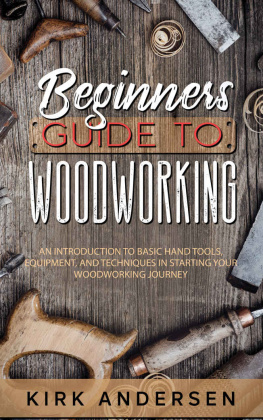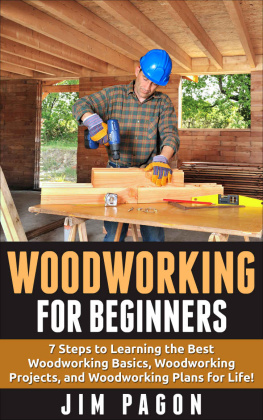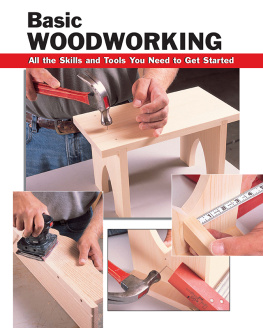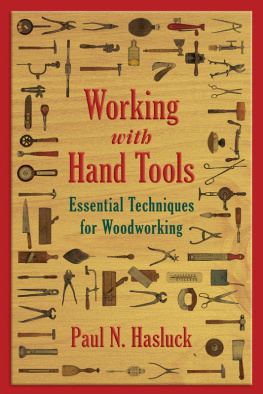The Foundations of Better Woodworking
By Jeff Miller
www.popularwoodworking.com
Preface
Over the course of a long teaching career, I have found that a large number of students even the most thoughtful and well-equipped lack the most fundamental level of knowledge and skills. Its no mystery that this core knowledge is missing; most of the woodworking literature and other woodworking media pays little attention to these fundamentals. Instead, the usual preference is to dive directly into a project or the specific techniques needed to handle some element of a project. Some articles and books cover methods of work, but still tend to omit the basic principles of wood, tools and body mechanics that need to be understood before one can successfully cut to a line, plane a surface flat and smooth, or fit a joint properly.
If a solid foundation of basic skills and knowledge is lacking, a woodworker will never perfect the techniques that he or she needs to advance. For example, its rarely a lack of information on how to cut dovetails that keeps most woodworkers from being able to cut the joint successfully. Its the lack of basic sawing skills, the inability to cut to a line properly, or the failure to wield a chisel effectively. These skills themselves are based on proper body position and mechanics, a fundamental understanding of the properties of wood, the knowledge of how the tools actually work and an understanding of just what it means to cut to a line.
Body position and biomechanics are the source of both the force and the control needed to use both the saw and the chisel properly. The knowledge of woods structure, in combination with an understanding of how these tools actually cut through wood, supply more vital information about how the tools should be used. And it all comes together when the woodworker understands just where in relationship to a marked line the wood needs to be removed. And of course, theres the element of practice. But knowing exactly what youre trying to accomplish when you practice is essential to your ability to get there. Without these fundamentals, no description of the steps involved in cutting the joint will make a difference in the ability to get the job done.
My own background is as a professional musician, both as a performer and as a teacher. It came as a great surprise to me that so many woodworkers didnt take a more systematic approach as they learned their craft. Musicians most often begin with basics of how to use the body properly for their instrument (or even more directly, for their voice). Hand position, posture and even breathing all play an important role. The foundation of music itself is studied as well; one learns about the underlying tonal and formal structure. And finally, music history rounds out the education; one learns not only about what music happened when, but also the nuances of style that go along with different types of music.
Musicians hear more in the music than casual listeners. Likewise, true craftsmen see more in both the wood and in the overall form, structure and details of a piece of furniture than the casual woodworker. This is the result of training, of either the ear or the eye.
Similar concepts apply to most athletic endeavors. Whether swinging a golf club or a tennis racket, running, cycling or swimming, the mechanics of how you use your body and how well you understand the specific demands of the sport and the equipment will have an enormous impact on how well you are able to perform.
Musicians and athletes have established methods for developing better fundamentals, and there are many different types of training resources that emphasize these essential basics. Woodworkers, in contrast, tend to get some tools, pick a project, and jump in. Some are able to succeed this way. An astute student will pick up some of the core knowledge through trial and error, or through careful observation of others. Much more can be learned under the eye of a good instructor, who can point out fundamental problems and guide the student toward correct usage of tools and the materials. But if the student doesnt begin to understand the basics, even this is not enough.
A traditional apprenticeship program provided much of the structure found in learning music or in athletic training. It not only taught the fundamentals, but also provided exposure to the masters high-level work. This made it absolutely clear what the end results needed to be. The apprentice slowly worked his way up from the simplest of tasks to the more complex, all directly under the supervision of the master and the higher- level workers in the shop.
My goal for this book is to create a significant resource for woodworkers to pull together as much of the fundamental woodworking knowledge as possible so it can be easily learned and then applied in a wide variety of woodworking situations. It cant quite be the equivalent of an apprenticeship, or working directly under a great teacher, but it should provide a more comprehensive understanding of the essentials of woodworking than is currently available with other resources.
My point is not to show you how to do everything. In fact, someone showing you how to do something doesnt mean that youre going to be able to do it at all. Instead, my goal is to provide a foundation of understanding upon which all woodworking skills can be built and improved.
Introduction
The content of this book might best be described with an analogy. Lets say you want to drive from your house to a friends new house in another state. To drive there you will need a number of things, many of which you might take for granted. First, youll need a car and the ability to drive that car. Also assumed is the knowledge of how a car works, the basics of driving on a system of roads and the various rules of the road. Youll need a map (digital or otherwise), and youll need to know the precise location of your destination. You also need some sort of feedback mechanism active the entire time youre driving, not only to keep you on your correct course, but also to keep your car on the road, traveling at an appropriate speed, and reacting to the vagaries of the traffic, road and weather conditions around you.
Most woodworkers are absolutely delighted by the car. And there are an awful lot of maps out there. But what about the exact destination, and how to actually drive the car and keep everything on course despite all of the usual and unforeseen variables one might encounter? These discussions are pretty rare. What do I mean by an exact destination? Much as you need a precise street address to get to a specific house when driving, in your woodworking you need to be able to envision precisely what youre trying to do.
Another analogy might be useful here. In music, its not enough to just know what notes youre supposed to play. You have to get the pitch and the volume right, and play that note at exactly the right time. You have to balance these things with other musicians who may also be playing. Theres more. In order for the music to make sense, you need to understand how each note fits into the melody and the harmony so that the music makes sense. And then you can start to shape musical phrases and express the musical ideas.



















